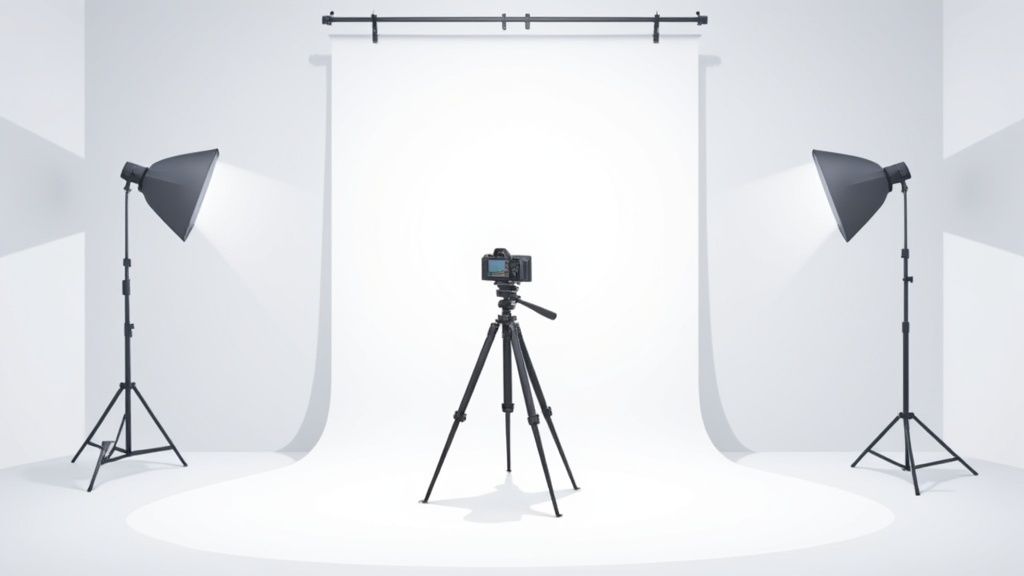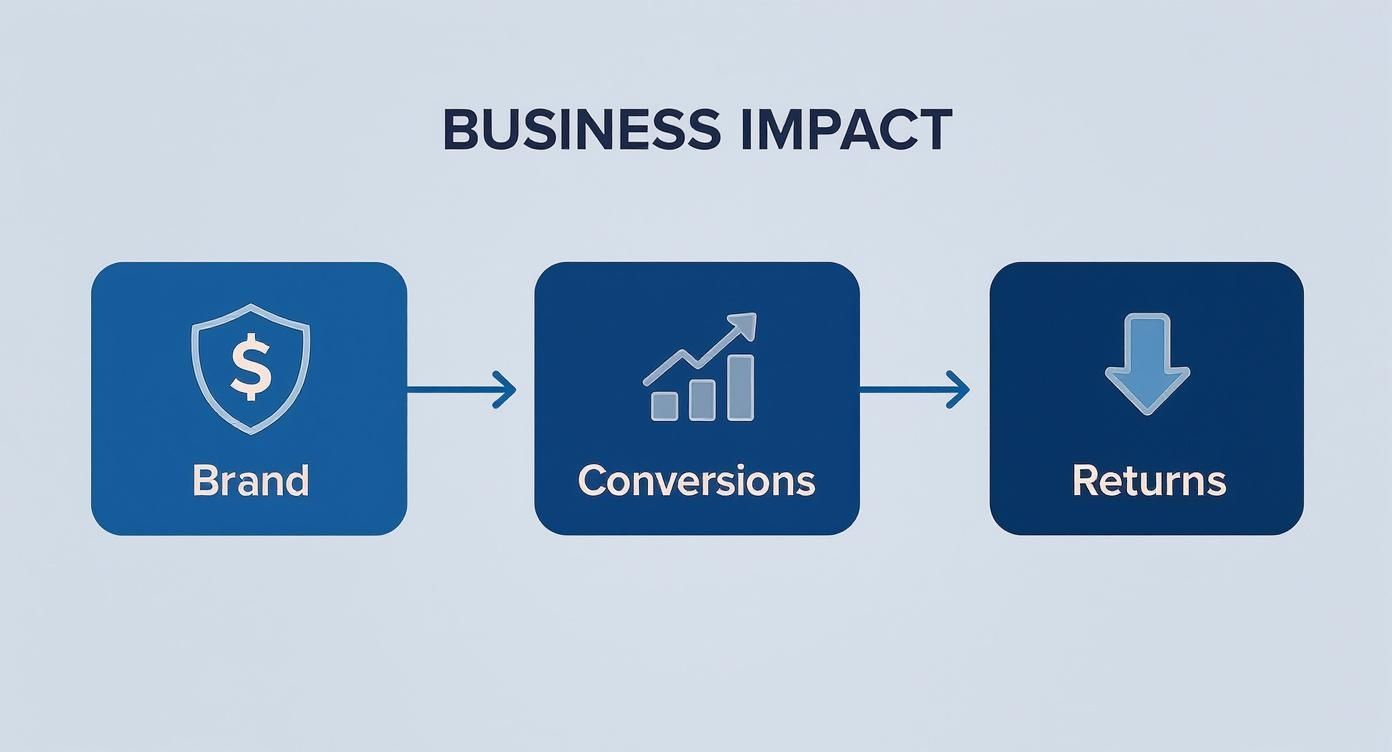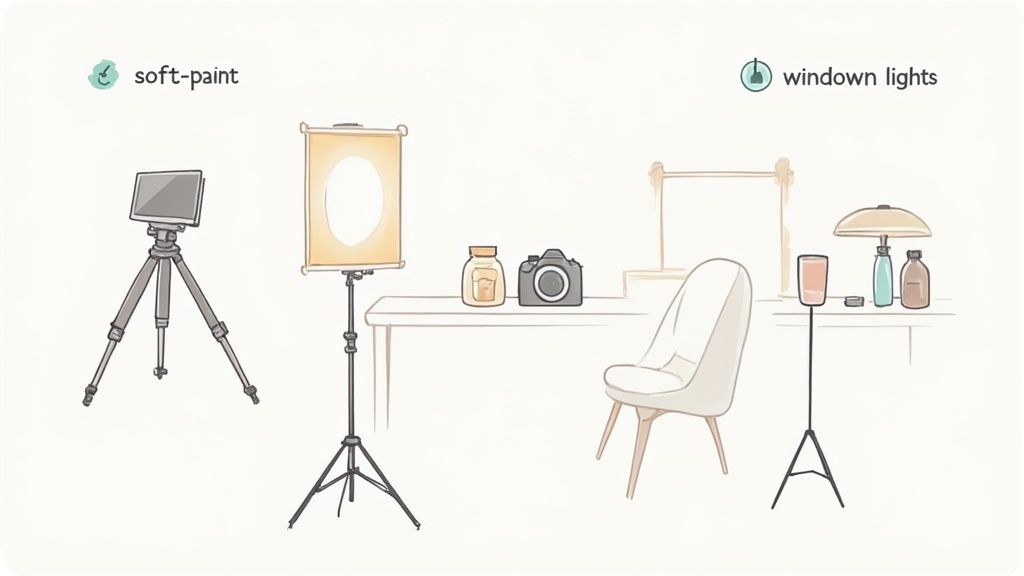What Is Product Photography and How Does It Work

Product photography is so much more than just taking a quick picture of something you want to sell. It's the craft of creating high-quality, enticing images specifically for commercial use. The real goal is to show a product in its absolute best light, making it irresistible to potential customers.
Think of it as your hardest-working digital salesperson—one that’s on the clock 24/7, building desire and closing deals.
What Is Product Photography Really

At its heart, product photography is a specialized field of commercial photography with a laser focus on one thing: showcasing a product both accurately and attractively. It’s the visual handshake between what a customer sees on their screen and the physical item that arrives at their door. This is especially true in e-commerce, where people can't physically touch or inspect the goods.
That’s why these images become the single most important factor in their buying decision.
This isn’t about just pointing and shooting. It’s a thoughtful process involving specific lighting setups, careful styling, and precise editing to tell the whole story visually. Good photography aims to answer all the questions a customer has but might not ask, like: What does it look like from the back? How big is it, really? What's the texture like up close?
The Art of Visual Storytelling
Truly great product photography tells a story. It doesn’t just display an object; it conveys its quality, its purpose, and its overall value. By strategically using light, composition, and context, a simple photo can trigger a feeling or paint a picture of a certain lifestyle, helping a customer see that product as part of their own life.
This is the key difference between a generic product listing and a memorable brand experience. A sterile, poorly lit photo of a handbag, for instance, says almost nothing. But an image of that same handbag on the arm of a well-dressed person navigating a bustling city street? That tells a story of sophistication, style, and everyday function.
This visual approach is incredibly effective because most of us are wired to respond to images. In fact, 65% of consumers are visual learners who connect more deeply with content that includes quality photos. This can boost views by as much as 94% compared to text-only content. You can explore more fascinating data about photography's impact on consumers at GreatBigPhotographyWorld.com.
A Vital Business Tool
When you get right down to it, product photography is a critical business tool. It’s not just about making things look pretty; it's about delivering real, measurable results for your bottom line. High-quality images directly impact your business by:
- Building Trust: Professional photos signal that you're a legitimate, trustworthy brand that cares about quality and detail. This gives customers the confidence they need to click "buy."
- Communicating Value: They let you highlight the fine craftsmanship, premium materials, and unique features that justify your product's price tag.
- Creating Desire: Beautiful visuals forge an emotional connection, turning casual browsers into eager buyers.
In the world of e-commerce, effective images are the silent engine that powers the entire sales process, bridging that all-important gap between seeing and buying.
To wrap up these core concepts, here's a quick summary of the essential elements of product photography.
Key Elements Of Product Photography at a Glance
| Element | Description |
|---|---|
| Fundamental Purpose | To showcase a product clearly and attractively for commercial use, primarily in e-commerce. |
| Common Types | Includes studio shots (white background), lifestyle photos (in context), detail shots, and scale shots. |
| Business Impact | Directly influences conversion rates, reduces product returns, and strengthens brand perception. |
Understanding these fundamentals is the first step toward using photography as a powerful tool for growth.
The Business Case for Investing in Great Product Photos
Let's be blunt: your product photos are not just window dressing for your online store. They're a core business asset, and probably one of the most powerful tools you have to make a sale. When a customer can't physically pick up, touch, or inspect your product, your images have to do all the heavy lifting.
Think of it like this: your product photography is the handshake, the sales pitch, and the product demo all rolled into one. It’s the bridge between a potential customer’s curiosity and their confidence to click “add to cart.” Blurry, poorly lit, or inconsistent images? That's a weak handshake that instantly creates doubt. But sharp, professional, and compelling photos can make even a brand-new shop look like a market leader.
Driving Conversions and Building Trust
The link between amazing photos and actual sales isn't just a gut feeling—it's backed by hard numbers. Online shoppers are almost entirely dependent on visual cues to make a decision. That puts a massive weight on your images to directly influence your conversion rate (the percentage of visitors who actually buy something).
Great photography tackles a customer's unspoken questions head-on. Is it well-made? What's the texture like? How big is it really? Clear, professional shots answer these questions, removing hesitation and paving the way for a sale. We dive deeper into turning great visuals into revenue in our guide on how to increase product sales.
The data doesn't lie. A staggering 75% of online shoppers say that product photos are a make-or-break factor in their decision to buy. Even more compelling? High-quality images have been shown to boost conversion rates by as much as 30%.
Reducing Returns and Strengthening Brand Identity
Getting the sale is one thing, but what about what happens after the purchase? This is where great photos play a crucial, often-overlooked role in customer satisfaction. When your images are a true-to-life representation of your product, customers know exactly what they’re getting. This simple act of setting clear expectations drastically cuts down on returns, saving you a world of financial and logistical pain.
Beyond that, your photos are the visual bedrock of your brand identity. When every image—from your website to your social media ads—shares a consistent, professional look, you start building something powerful: a recognizable and trustworthy brand. This is especially true on competitive platforms where visuals are everything. For instance, a solid Google Shopping Ads tutorial will show you that compelling photography is non-negotiable for getting clicks. That visual consistency sends a clear message that you’re a serious, detail-oriented business that cares about the customer experience from start to finish.
Exploring Different Types of Product Photography
A single photo rarely tells the whole story. To build a compelling product page that actually converts, you need a full gallery of images working together, with each one serving a specific purpose. Knowing the different types of product photography lets you strategically answer customer questions before they're even asked, build genuine trust, and create a real sense of desire.
Think of your product page's photo gallery as a team of specialists. You have the straightforward expert, the relatable storyteller, and the meticulous inspector. Each one has a job to do, and together, they paint a complete picture that leaves no room for doubt.
This infographic breaks down how different visual approaches contribute to key business outcomes.

As you can see, strong visuals reinforce your brand identity, boost conversion rates, and even help reduce product returns by setting crystal-clear expectations from the start.
The Essential White Background Shot
The white background shot is the undisputed workhorse of e-commerce. Often called a studio or individual shot, this style isolates the product against a clean, distraction-free backdrop, making it the hero. Its entire purpose is clarity and consistency.
You’ll see these everywhere because major marketplaces like Amazon and Google Shopping often require them for primary listings. They create a uniform, professional look across millions of products, helping customers compare items at a glance. Think of it as your product’s official headshot—clear, direct, and all business.
Bringing Products to Life with Lifestyle Photos
While studio shots inform, lifestyle photos inspire. These images place your product in a real-world context, helping customers instantly visualize it as part of their own lives. A photo of a backpack on a hiker cresting a hill or a coffee mug sitting on a sun-drenched desk tells a story that a sterile white background never could.
Lifestyle photography is about selling an experience, not just an item. It bridges the emotional gap by showing the "why" behind the product, making it far more relatable and desirable to your target audience.
These shots are gold for social media, website banners, and email marketing. They're designed to grab attention and forge an emotional connection with your brand.
Answering the "How Big Is It?" Question
One of the trickiest parts of selling online is communicating a product's true size. A scale shot tackles this head-on by placing your item next to a familiar object or a person, giving customers an immediate, intuitive sense of its dimensions.
For instance, showing a slim wallet in someone’s hand or a new armchair in a fully decorated room communicates size far more effectively than a list of measurements ever could. It’s a simple but powerful technique for managing customer expectations and can dramatically cut down on returns from people who just misjudged the size.
Showcasing Quality with Detail Shots
When your product's value is in its craftsmanship, a detail shot is non-negotiable. These are extreme close-ups—sometimes called macro shots—that highlight the specific features justifying your product's price tag. Think of the intricate stitching on a leather bag, the brushed metal finish on a watch, or the rich texture of a hand-woven blanket.
These images build a ton of confidence. They essentially invite customers to zoom in and appreciate the little things that make your product special, proving you stand behind the quality of your materials and construction.
Putting It All Together
To help you decide which photos your product needs, here’s a quick comparison of the most common types and where they shine.
Product Photography Types Compared
| Photography Type | Primary Use Case | Key Benefit |
|---|---|---|
| White Background | Main product listing images on marketplaces like Amazon and your own store. | Provides a clean, consistent, and distraction-free view of the product. |
| Lifestyle | Social media, website banners, blog posts, and email marketing. | Connects emotionally with customers by showing the product in a relatable context. |
| Scale Shot | Product pages, especially for items where size is a key purchasing factor. | Manages expectations and reduces returns by clearly communicating dimensions. |
| Detail (Macro) Shot | Product pages for high-quality or intricate items. | Highlights craftsmanship and builds trust in the product's quality and value. |
| Group Shot | Showing product variations (colors/sizes) or selling bundles and kits. | Encourages upselling and simplifies the presentation of multiple related items. |
By strategically combining these different types of photos, you create a comprehensive visual narrative. You're not just showing what a product looks like; you're explaining its value, demonstrating its use, and helping customers feel confident in their decision to click "Add to Cart."
Your Essential Gear and Studio Setup

Jumping into product photography doesn't mean you need to rent out a massive studio. Honestly, you can pull off a professional-looking setup on just about any budget. The real secret isn't about dropping a ton of cash on fancy gear; it's about understanding and controlling a few key elements.
Think of it this way: your setup has three core pillars. You need a camera to capture the image, a stable base to keep it sharp, and the right light to make your product look its best. Once you get these basics down, you’ve built the foundation for every great product shot you'll ever take.
Choosing Your Camera
The first thing that comes to mind is the camera, of course. But you probably have more options than you think. While a professional DSLR or mirrorless camera gives you incredible manual control over things like aperture and shutter speed, it’s far from your only choice.
Don't underestimate the power of the phone in your pocket. Modern smartphones have incredibly capable cameras. With impressive resolution and smart software doing a lot of the heavy lifting, your phone is a fantastic tool, especially when you're just starting out. The trick is to work with what you've got and let the other elements of your setup do the work to elevate your final images.
The Foundation A Tripod and Backdrop
Regardless of whether you're using a high-end camera or your iPhone, a tripod is non-negotiable. It has one job, and it does it perfectly: it eliminates camera shake. This is the key to getting consistently crisp, clear images. It also lets you use slower shutter speeds to soak up more light without ending up with a blurry mess. Even a simple tripod under $30 is one of the smartest investments you can make for an immediate jump in quality.
Next up is your backdrop, which literally sets the stage for your product. For those clean, classic e-commerce shots, a simple white background is the gold standard. You can nail this look with a large sheet of white poster board or a paper "sweep" that curves smoothly from the wall down and under your product, creating a seamless, floating effect.
A simple setup—a camera, a tripod, and a clean backdrop—is the core of any product photography studio. It provides the stability and distraction-free environment needed to make your product the hero of the shot.
Mastering Your Lighting
If there’s one element that can make or break your photo, it's lighting. It dictates the mood, highlights texture, and makes your product leap off the screen. You have two main routes to go here, and both can give you incredible results.
- Natural Light: This is the best budget-friendly option out there. Using a large window as your main light source provides soft, diffused light that’s flattering for almost any product. Just set up your product at a 90-degree angle to the window, and you'll get beautiful, gentle shadows that add a sense of depth and dimension.
- Artificial Light: If you need more control and consistency (or just want to shoot after the sun goes down), artificial lights are the way to go. A softbox is a great place to start; it spreads light from a bulb through a diffusion panel, recreating that soft window-light effect. We actually put together a full guide on building a DIY product photography setup if you want a complete, budget-friendly lighting solution.
By getting a handle on these essential pieces of gear, you're not just taking pictures—you're creating consistent, professional, and compelling images that will help drive your business forward.
How AI Is Shaping Modern Product Photography
https://www.youtube.com/embed/Wrkw9HjOP4w
The world of product photography is changing fast, and artificial intelligence is at the heart of it all. What once felt like science fiction is now a practical tool for photographers and brands everywhere. AI is stepping in to handle the grunt work, unlocking new creative possibilities and making top-tier imagery more accessible than ever.
Think of it this way: instead of spending hours meticulously cutting out a product from its background or tweaking color balances, a photographer can now let an AI-powered tool take over. This frees them up to focus on what really matters—the composition, the lighting, the story. It’s all about working smarter.
Automating the Post-Production Workflow
One of the biggest game-changers AI brings is to the editing suite. Tasks that used to take ages and a highly specialized skillset can now be done in a matter of seconds. For brands, this automation means they can churn out consistent, professional-looking images faster and at a scale that was previously unimaginable.
AI really shines at tasks like:
- Background Removal: It can instantly pull a product out of its original setting, giving you a clean, transparent background perfect for e-commerce.
- Color Correction: AI algorithms automatically ensure colors are true-to-life, vibrant, and consistent across your entire product catalog.
- Shadow Generation: It can create natural-looking shadows that add depth and make your products look like they belong in the scene.
These aren't just minor conveniences; they represent a fundamental shift. Tools like Adobe Sensei are automating these complex jobs with incredible accuracy. This trend is a major force behind the growth of the global photography market, which is expected to expand at a CAGR of 4.4% and hit an estimated $161.8 billion by 2030.
AI isn't here to replace creative professionals—it's here to partner with them. By taking over the most repetitive parts of the job, it gives photographers the freedom to focus on the human elements that make an image truly great.
The Rise of Virtual and Generative AI Photography
But AI’s influence doesn’t stop at editing. It’s pioneering entirely new methods for creating product visuals without ever picking up a camera. Virtual photography and generative AI are giving businesses stunning, photorealistic images that are built from the ground up.
This approach is a lifesaver when you need to create unique lifestyle shots or place products in settings that would be too expensive or logistically impossible to arrange for a real photoshoot. If you're looking to dive deeper into how AI can transform your process, check out our guide on AI product photography.
As we look forward, the distinction between a photograph and a digital creation is only going to get blurrier. We're even seeing the emergence of powerful AI product video generator tools that can create dynamic video content almost instantly. AI is completely redefining what's possible, making product photography more efficient, scalable, and creatively liberating than ever before.
Answering Your Top Product Photography Questions
Getting started with product photography always kicks up a lot of questions. What gear do I need? How many pictures is enough? Finding solid answers is the first step toward building a visual strategy that actually sells.
Let's cut through the noise and tackle some of the most common questions head-on. This is your go-to guide for getting past those early hurdles and making smart decisions for your business with confidence.
Can I Really Just Use My Phone?
Yes, absolutely. The camera in your pocket is a powerhouse, and it's more than capable of capturing stunning, professional-looking product photos. The secret isn't a thousand-dollar camera body; it's controlling the world around your product.
Nail the fundamentals, and you'll be golden. Find a big, soft light source (a window is perfect), pop your phone on a tripod to keep things tack-sharp, and use the built-in gridlines to line up a beautiful composition. From there, a quick spin through a mobile editing app to tweak brightness, contrast, and color can make a world of difference.
How Many Photos Do I Need for Each Product?
There’s no single magic number, but a great rule of thumb is to aim for 5-8 photos per product. The goal is simple: show enough images to answer every question a customer could possibly have before they even think to ask it.
Think of your image gallery as a visual conversation with your customer. You need to tell the whole story.
- Start with a clean "hero" shot on a simple background.
- Add lifestyle photos showing the product in its natural habitat.
- Show it from all sides—front, back, top, you name it.
- Get in close with detail shots that highlight texture, materials, and quality.
- Include a shot that clearly shows the product's scale.
It all comes down to building trust. You want to erase any doubt that might stop someone from clicking "buy."
At its core, product photography closes the gap between an online store and a real-life object. A great set of photos is the closest you can get to letting a customer pick up your product and hold it in their hands.
What’s the Difference Between Product and Commercial Photography?
This is a really common question, but the difference is pretty straightforward. Think of it this way: Product photography is a specific discipline within the larger world of commercial photography. Its entire purpose is to showcase a product in a clear, appealing way to drive a sale, usually for an e-commerce site or a catalog.
Commercial photography is the big umbrella term. It covers any photo taken for business purposes. That includes product shots, but it also covers lifestyle photos for an ad campaign, corporate headshots for a company website, or architectural photos for a real estate brochure. Simply put, all product photography is commercial, but not all commercial photography is product photography.
Is Editing My Product Photos Really That Important?
Yes. 100%. Post-processing isn't just a nice-to-have; it's a non-negotiable part of the job. Even if you get everything right with your camera and lighting, the editing suite is where a good photo becomes a great, sales-driving asset.
Editing is crucial for a few key reasons. It’s how you ensure the colors in your photo are a perfect match for the real-world product—a huge factor in keeping returns down. It's also where you can perfect the exposure, clean up tiny specks of dust you didn't see, and create a consistent, polished look across your entire store. That final touch is what communicates professionalism and builds a brand people trust.
Ready to create stunning, high-quality images without the hassle of a photo shoot? QuickPixel uses AI to transform your existing product photos into professional, studio-grade shots that are ready for any marketplace. Get started today and see how easy it is to make your products look their absolute best.
Try QuickPixel Today
Get started with our AI-powered image generation tools